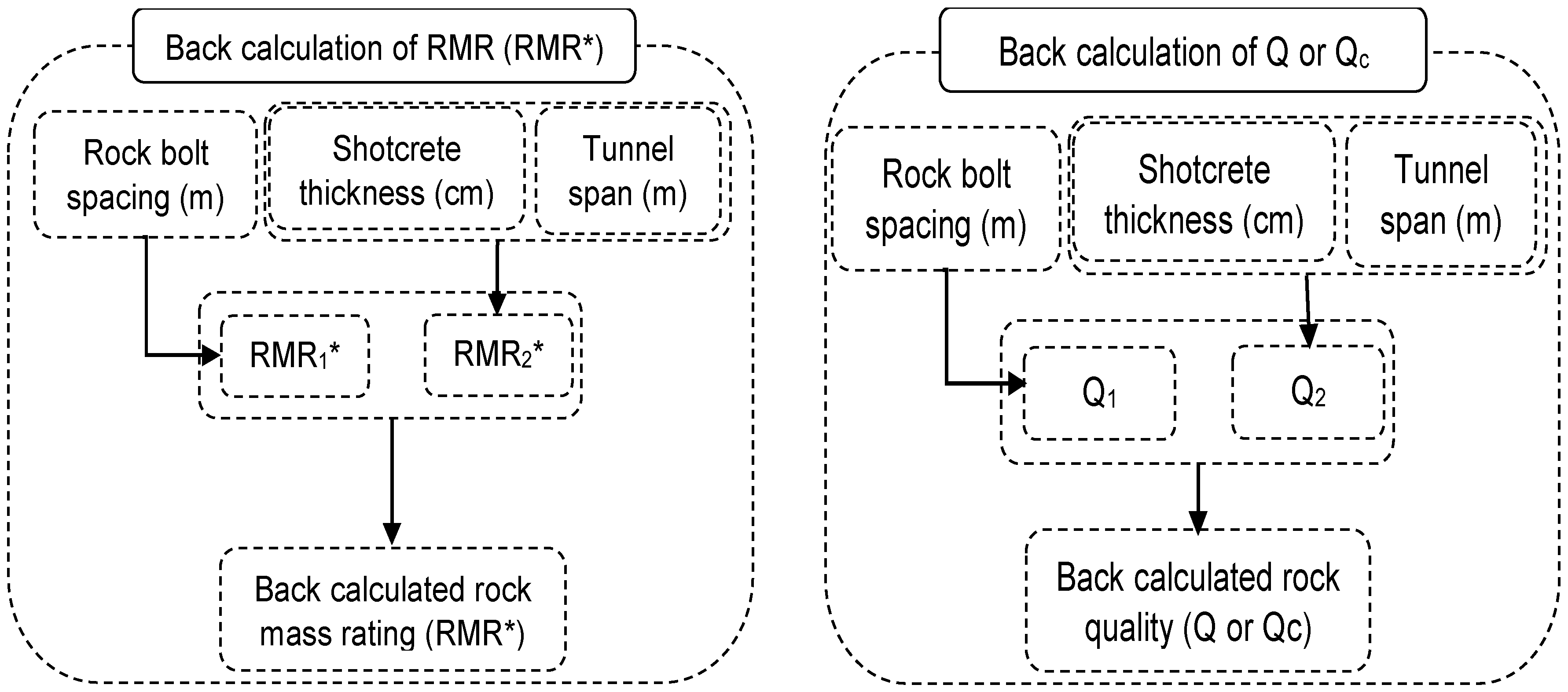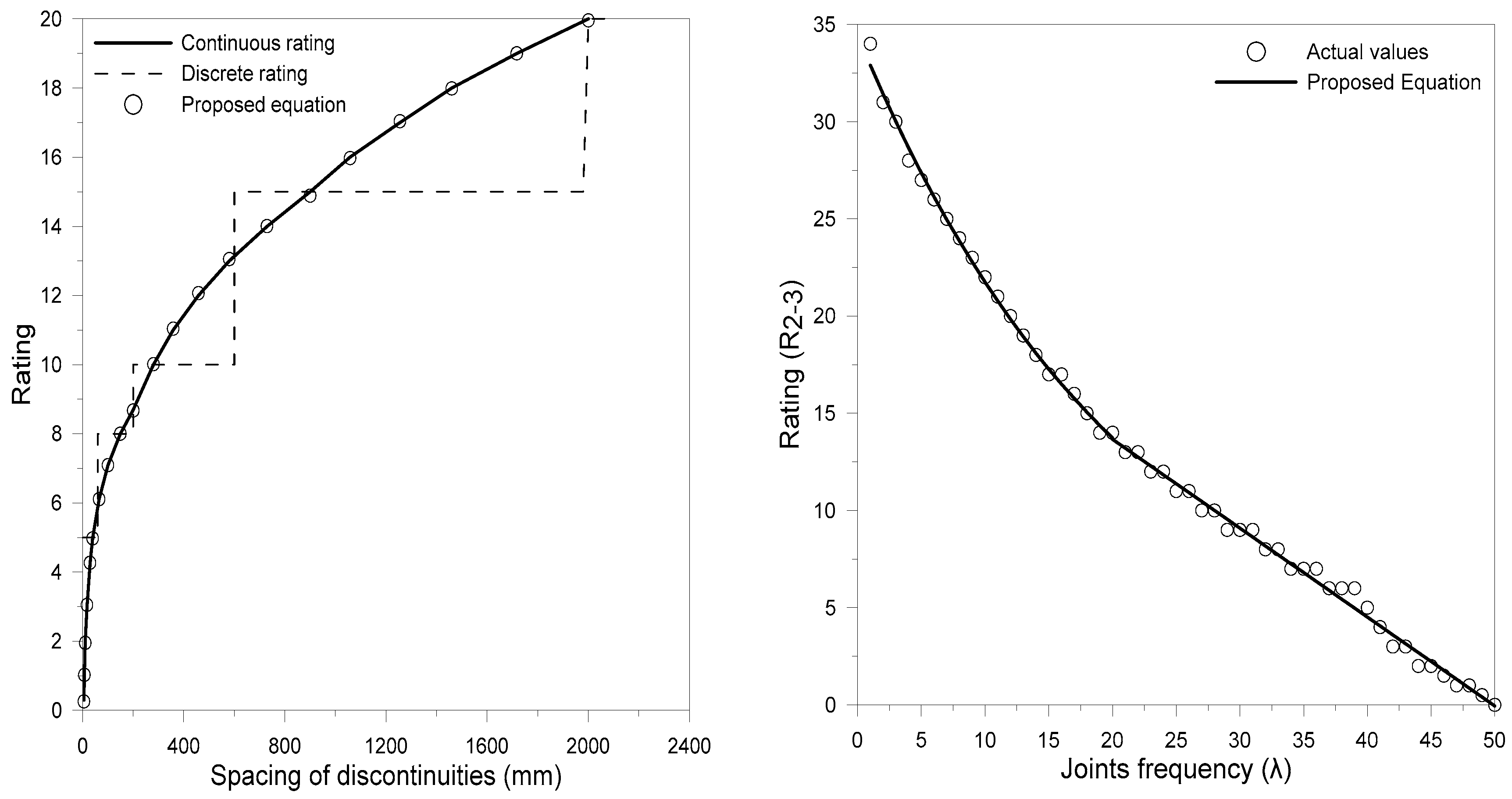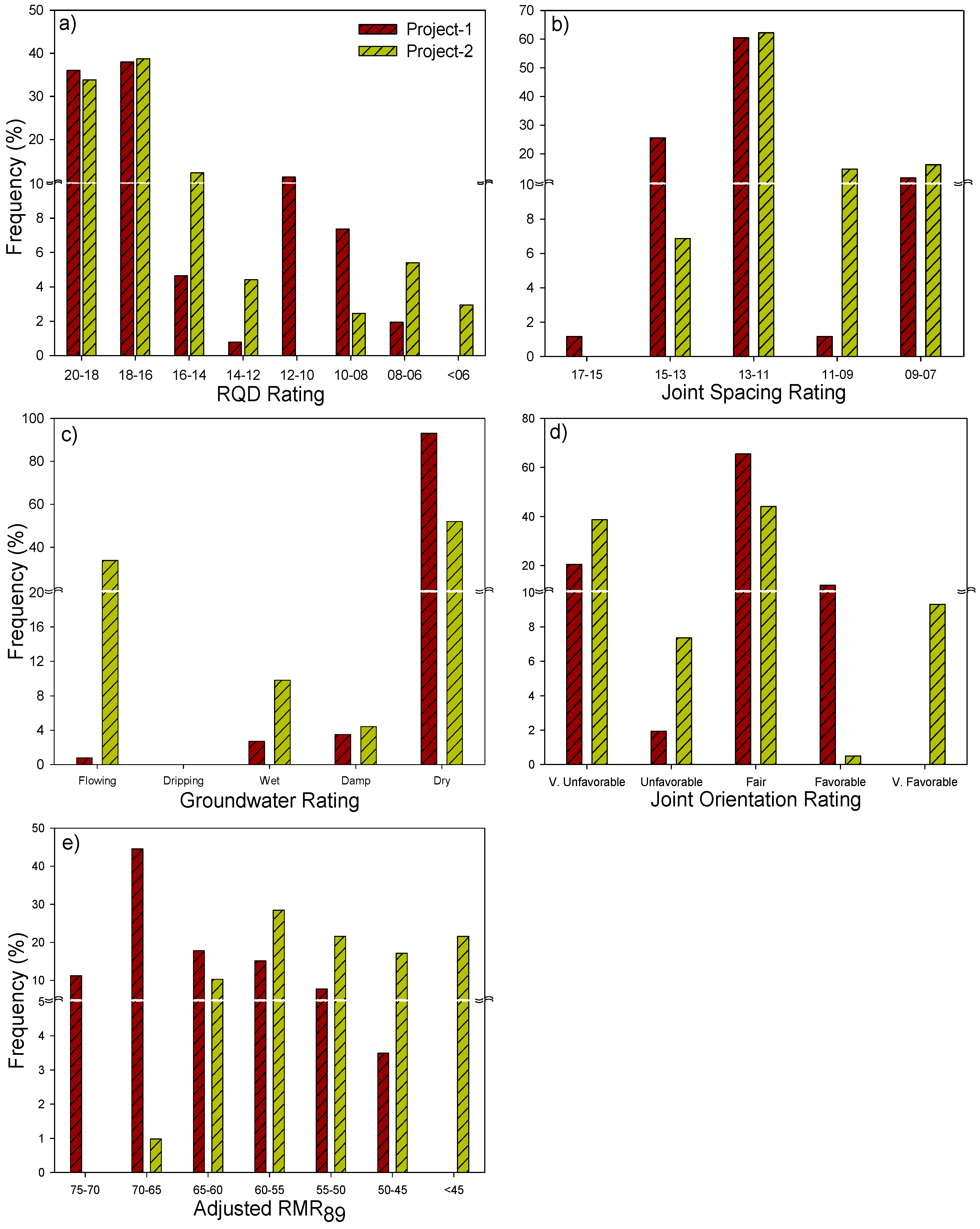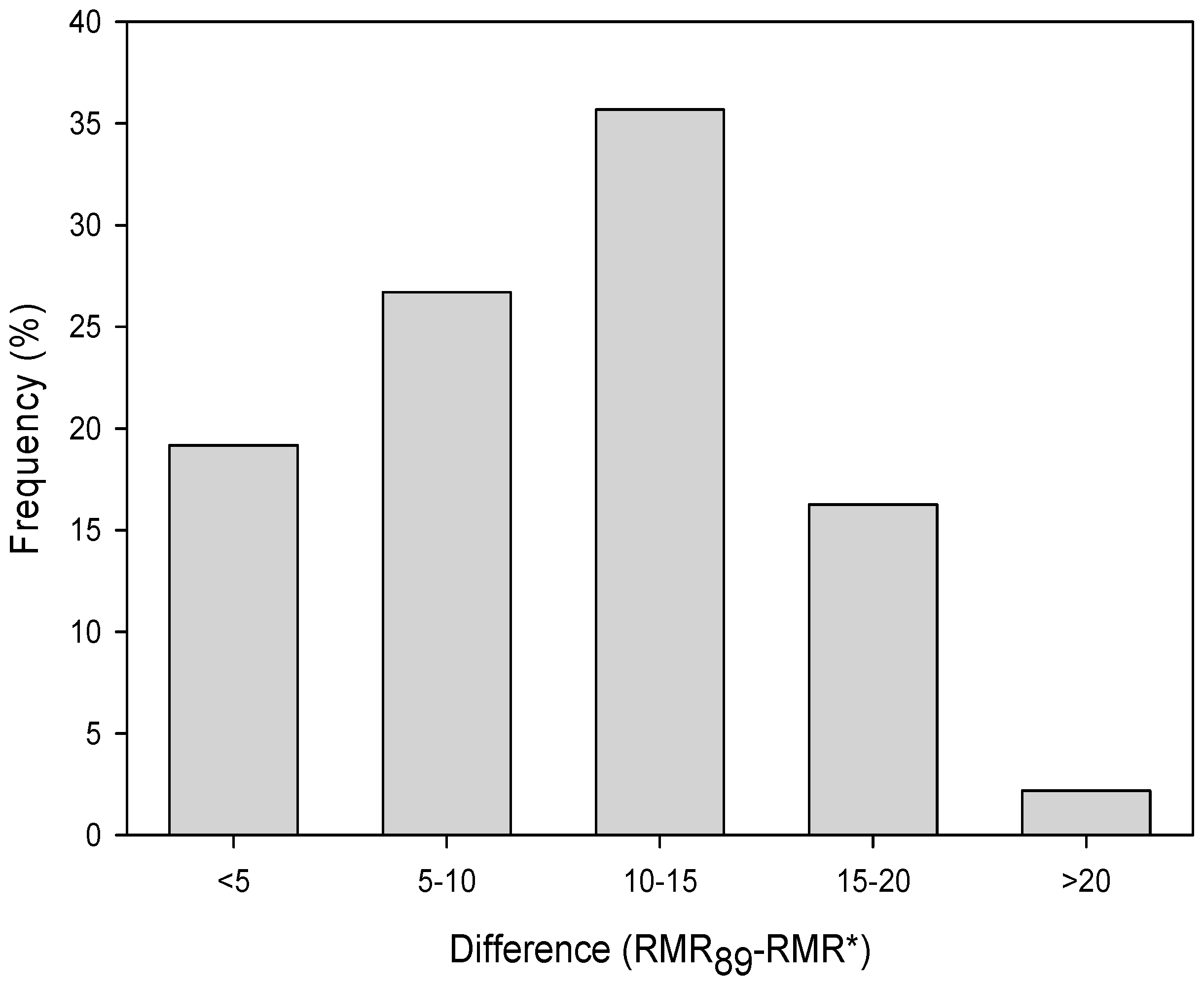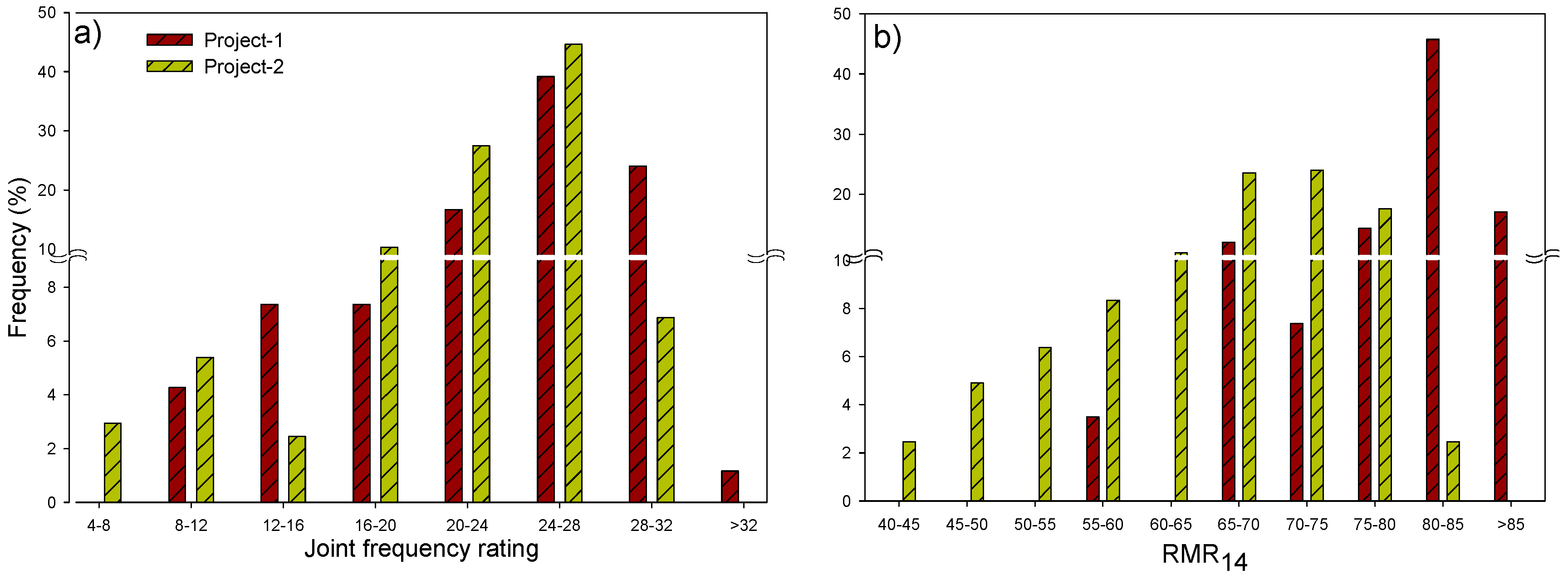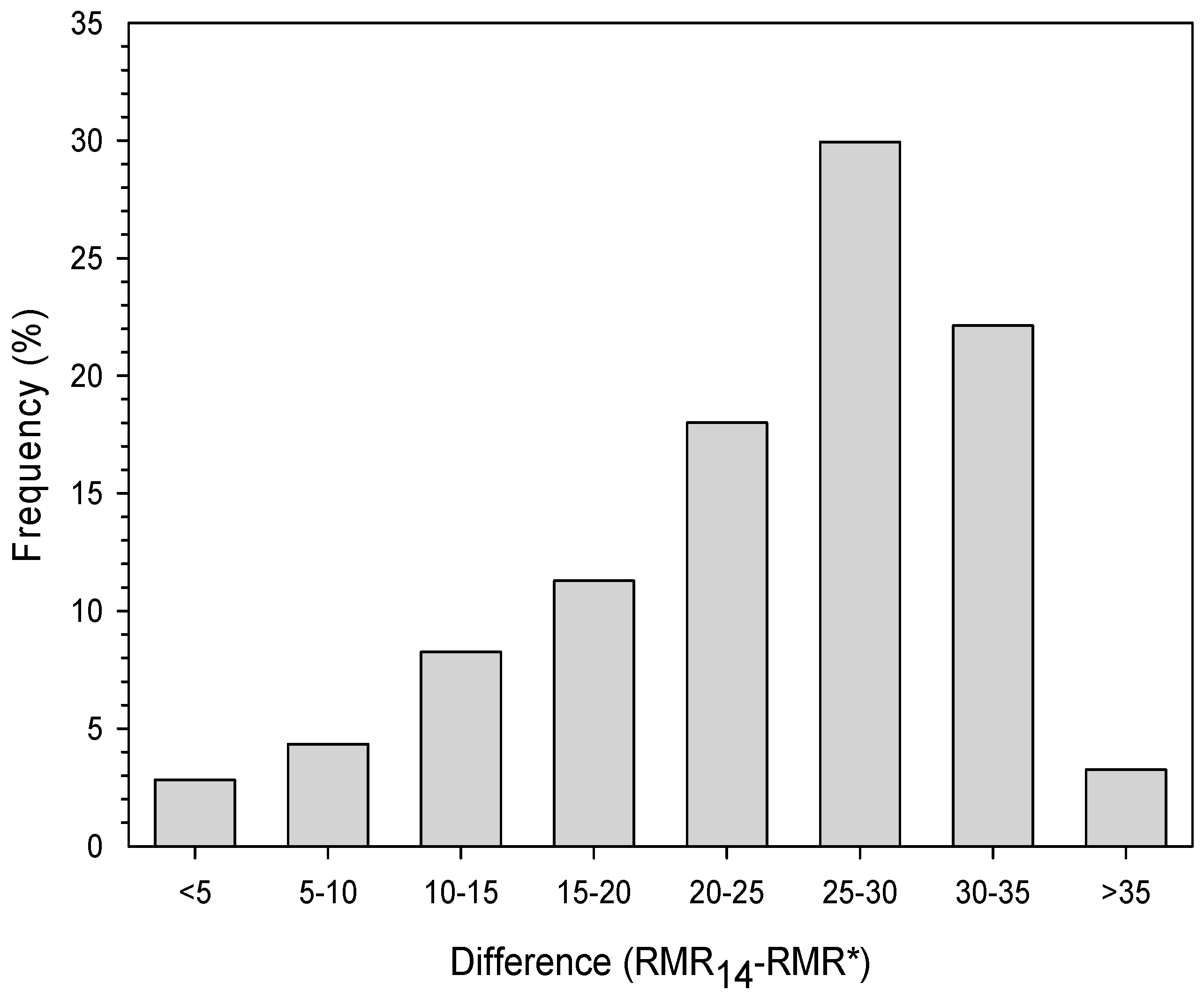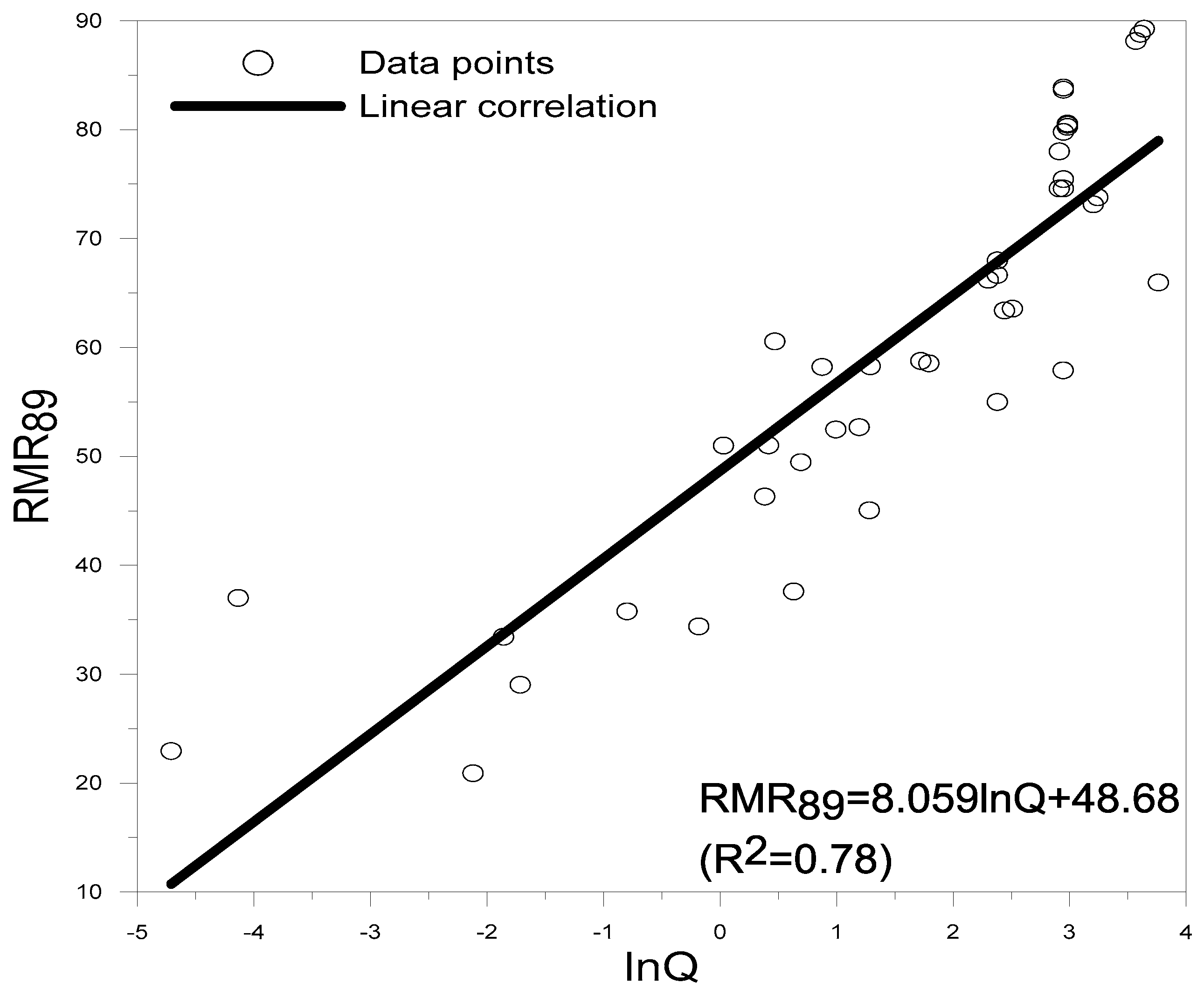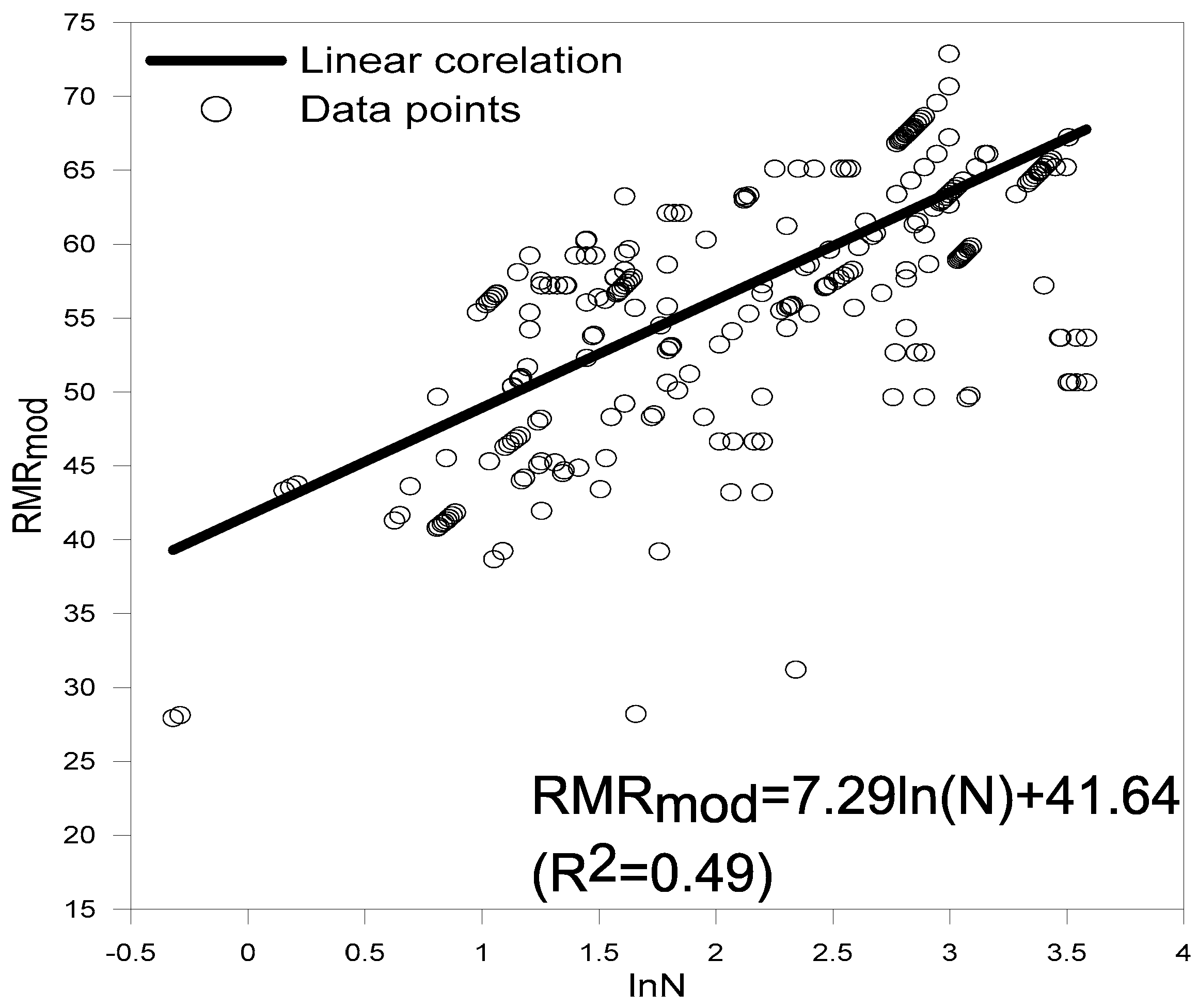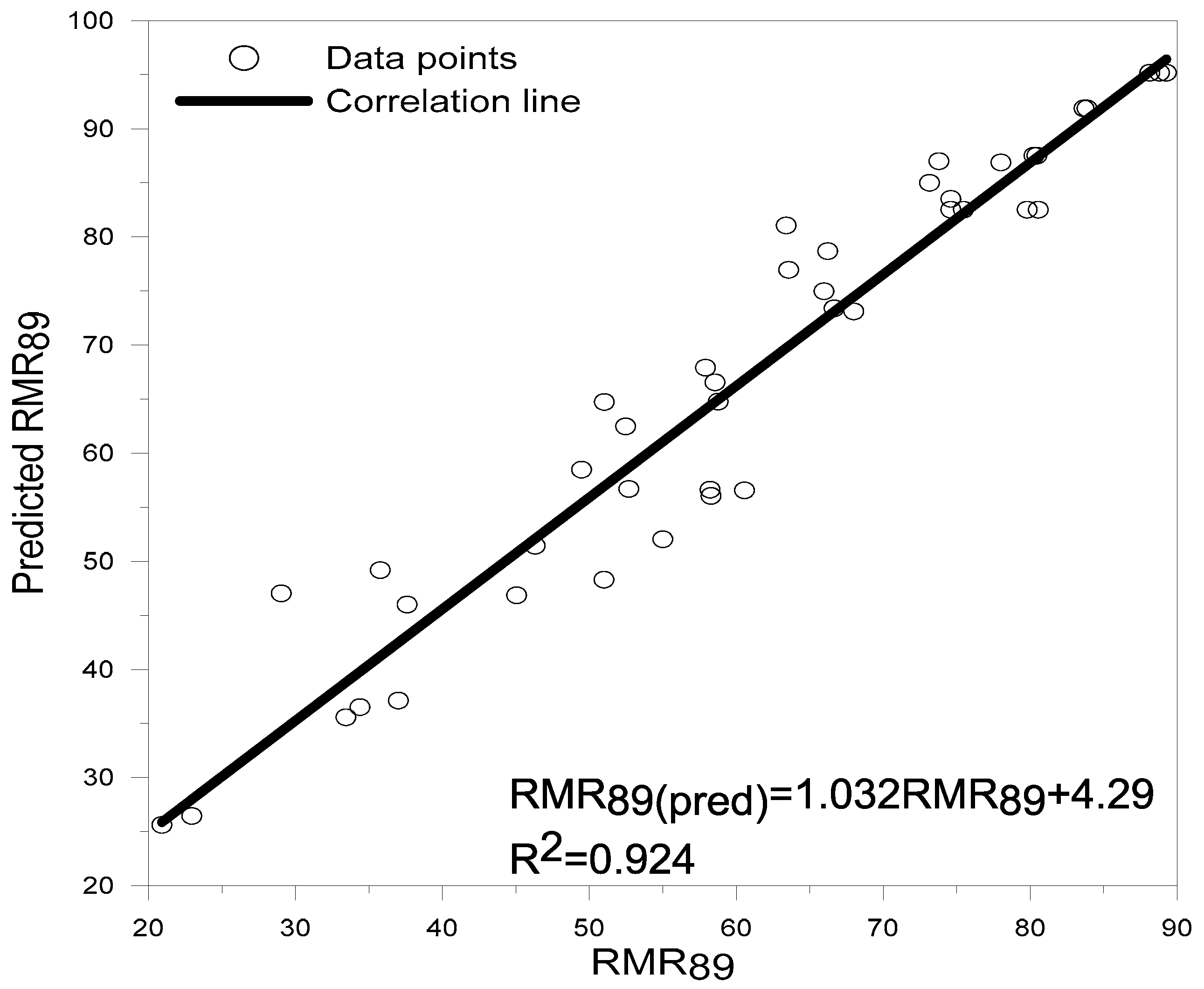2.3. Characterization and Classification of Rock Mass Based on RMR89
The geomechanics classification system, also known the rock mass rating classification system, was developed by Z. T. Bieniawski [
5]. This classification system has been continuously refined over several years, and its characterization criteria have been revised from its creation onwards [
5,
6,
7,
15,
20,
21,
22,
23], as summarized in
Table 1. Major revisions to the system were proposed in 1989 [
6]. These include new charts and tables, which were added for the rating of intact rock strength (
σc), rock quality designation (
RQD), discontinuities/joint spacing, and the condition of discontinuity parameters. The refined
RMR system is termed as the
RMR89 version. The basic
RMR (
RMRb) value is the sum of the ratings of five declared parameters. It includes the rating for intact rock strength (
R1),
RQD (
R2), joint spacing (
R3), joint condition (
R4), and groundwater condition (
R5). The
RMR89 system is the result reached after adjusting
RMRb for discontinuity orientation with respect to the tunnel orientation and excavation direction rating (
R6). These six parameters describe the rock mass rating,
RMR89, and the corresponding quality is obtained using Equation (1):
To date,
RMR89 continues to be used in the tunneling field even after its latest version, called
RMR14, was made effective. Although there are graphical approaches for the precise rating of
RQD, intact rock strength and discontinuity spacing [
6], most users select the discrete/lump rating values using the
RMR89 table [
24,
25,
26,
27]. The continuous rating concept through using equations was introduced by Sen and Sadagah using the lump rating system of the
RMR73. This reveals that the minimum value of the worst
RMR value is 8 [
28], but the worst is actually 0 in
RMR89 [
23].
The rating for intact rock strength (
R1) is from 0 to 15. A rock with a uniaxial compressive strength (UCS) greater than 250 MPa is assigned maximum points, and that with less than 1 MPa is assigned minimum points. The continuous rating between them can be determined using Equation (2):
Since its development [
29],
RQD has been used in
RMR and
Q systems because of its historical background. Because of several inherent limitations, and ignoring the basic definition [
4,
30], this parameter is not used in the latest version of
RMR. Along with the joint spacing,
RQD was replaced by joint frequency [
15]. It remains a mandatory parameter in the
Q system. According to
RMR89, the rating of
RQD (
R2) is from 3 to 20 based on the average values. For graphical rating, which is a more precise method of characterization, the range of
RQD rating for
RMR89 is clarified [
23], and after this clarification the continuous rating of
RQD can be determined from Equation (3):
The discontinuity spacing rating (
R3) is applicable for a rock mass having three joint sets. When less than three sets of discontinuities are present,
R3 should be increased by 30%. However, without this, a conservative assessment is performed [
6]. Like
RQD, the range of ratings for joint spacing is from 5 to 20 based on the average value. However, the range of graphical ratings for joint spacing in
RMR89 is also clarified as with
RQD [
23], and after this clarification, the continuous rating of joint spacing (
x) in
RMR89 can be determined from Equation (4):
A modified criterion, introduced for
RMRb calculation, replaced
RQD and the discontinuity spacing by the number of joints per meter (frequency) in the excavation face. The joint frequency (
λ) parameter, consisting of
RQD and joint spacing parameters, is evaluated with the chart provided by Lowson and Bieniawski [
15]. The joint spacing and
RQD are functions of the fracture frequency and can be determined either directly or indirectly. The first indirect method used for fracture frequency determination is a mathematical equation between the fracture frequency and
RQD, as given by Equation (5) [
31]:
When data are available, both in terms of the number of joint sets and average spacing between joints of each joint set, the joint frequency is determined using Equation (6):
The continuous rating for joint frequency (
R2–3) can be determined using Equation (7) for
= 1–50. If the joint frequency is less than 1, the rating will be maximum, i.e., 40.
The joint condition term and its corresponding rating (
R4) are the function of the discontinuity length (m), separation (mm), roughness, infilling (mm), and weathering. The rating
R4 can be selected for
RMR89 using the detail listed in
Table 2, but some conditions are mutually exclusive; i.e., in the case of the infilling material, the roughness is overshadowed by the infilling influence [
6]. However, this aspect is missing when calculating ratings for joint conditions [
24]. The best approach to rating groundwater (
R5) is to calculate its inflow rate. However, the general condition is usually used for this purpose. The rating for the joint orientation (
R6) is the qualitative term and depends on the orientation of the main joint set with respect to the tunnel orientation and direction of excavation.
The modified criteria, as discussed above, show that
RMR89 can be expressed in terms of five parameters and calculated using Equation (8):
The state of stress is barely considered in rock mass rating classification systems for tunneling. The
RMR calculation practice [
5,
22] does not account for stress in tunneling, but an adjustment to the
RMR89 rating is suggested for the stress condition (in situ stress and changes of stresses) when it is used for mining applications [
6]. The case histories on which
RMR89 is based show that tunnels are located at shallow depths and stress is not a major factor involved in the design of a tunnel. A rating adjustment for stresses was suggested based on the strength to stress ratio (
σc/
σ1) for
RMR89 in a high-stress environment [
32].
2.4. Characterization and Classification of Rock Mass Based on RMR14
After the use of
RMR89 for 25 years, an updated version of
RMR known as
RMR14 is suggested with a few new parameters, revised rating, and final structure [
7]. The structure of
RMR14 for determining rock mass quality is represented by Equation (9):
where
RMRb = Basic RMR (without the influence of excavation),
F0 = Adjustment factor similar to R6 in RMR89,
Fe = Adjustment factor for the excavation method,
Fs = Adjustment factor for the stress-strain behavior at the tunnel face.
The RMR14 structure preserves four parameters with their ratings in the original form as found in RMR89. As per the modification in 2013, these are as follows:
The discontinuity condition was revised in
RMR14 by eliminating the joint aperture parameter because of the overshadowing effect. The revised ratings for the remaining four parameters of the discontinuity condition for
RMR14 are summarized in
Table 2.
Three new parameters, i.e., intact rock alterability and adjustment parameters
Fe, and
Fs, were also introduced in
RMR14. The intact rock alterability is rated per results of the slake durability test, as defined in the standard [
33]. The rating values of the rock alterability parameter were suggested in table form in the
RMR14 version. The parameter
Fe, which is a function of
RMR and related to the mechanical excavation method, can be calculated from Equation (10) [
7]:
where
RMR =
RMR89.
Equation (10) is applicable for mechanical excavation only. When the excavation is performed by the drill and blast method, Fe = 1.
During excavation,
RMR at the tunnel face is considerably lower than predicted during the design phase because of the yielding of the tunnel face and walls. To overcome this effect, an adjustment factor (
Fs) is introduced. This factor was defined in terms of Índice de Comportamiento Elástico (
ICE) (elastic behavior index) by Bieniawski and Celada [
34], as expressed in Equation (11). The Kirsch solution for stresses at the perimeter of a circular excavation was used for
ICE determination and has been extended to non-circular tunnels using numerical modelling. For the derivation of Equation (11), Equation (12) of Kalamaras and Bieniawski [
35] was used for calculating rock mass strength:
where
σci = intact rock uniaxial compressive strength (UCS) (MPa),
K0 = virgin stress ratio,
H = tunnel depth (m), and
F = shape coefficient (
F = 1 for 10 m diameter circular tunnel;
F = 1.3 for 6 m diameter circular tunnel and
F = 0.75 for 14 m wide conventional oval tunnel [
34]).
RMR = RMR89.
The value of
ICE obtained from Equation (11) is used for the calculation of the adjustment factor,
Fs, using Equation (13):
2.5. Characterization and Classification of the Rock Mass Based on Tunneling Quality Index (Q) System
The tunneling quality index, also known as the
Q system, is a tunneling data-based empirical classification system that was presented in 1974 [
8]. The system categorizes the ground into nine rock mass classes. On a logarithmic scale, the quality index ranges from 0.001 to 1000 and is calculated using Equation (14):
where
RQD is used at intervals of five in a selected domain,
Jn denotes the rating of the number of joint sets,
Jr is the rating for the joint surface roughness,
Ja denotes the rating for the degree of alteration or clay filling joint set,
Jw denotes the ratings for groundwater inflow and pressure effects, and stress reduction factor (
SRF) is the rating for faulting, strength – stress ratios in hard rocks, and squeezing or swelling.
Since the introduction of the
Q system, major changes in characterization were proposed in terms of intact rock strength and
SRF for competent rocks with a rock stress problem [
9,
10,
36]. In rock mass properties, the role of intact rock UCS is significant. Thus, a normalization factor is applied to Equation (14) for a modified
Qc [
10]:
The ratings for
σc are their values in Equation (15). The ratings for
RQD are their values with a correction interval of 5, i.e., 90, 85, 80, etc., as suggested by Barton [
8]. In the literature, this suggestion related to
RQD is usually not included in
Q or
Qc calculation [
24,
25]. In the case of massive hard rocks, the rating for
Jr is 4, and in cases where the joint fill is thick enough to prevent rock wall contact during shearing, the rating for
Jr is always 1 [
11]. Although no parameter is directly included in the structure of the tunneling quality index system for joint orientation, the discontinuity filling and roughness, i.e.,
Ja and
Jr, respectively, are calculated for the least favorable joint orientation [
10]. The first term in Equations (14) and (15) is the relative block size, which is suitable for distinguishing rocks-burst-prone rock from jointed rock. The rock-burst-prone rock has an
RQD/
Jn ratio of 25–200, whereas the typical jointed rock has an
RQD/
Jn of 10 [
10]. The
SRF rating in the case of competent rock with a rock-stress problem has been modified for massive and jointed rocks [
9,
36]. The continuous rating of
SRF in Equation (15) can be determined for highly stressed jointed rocks using Equation (16):
